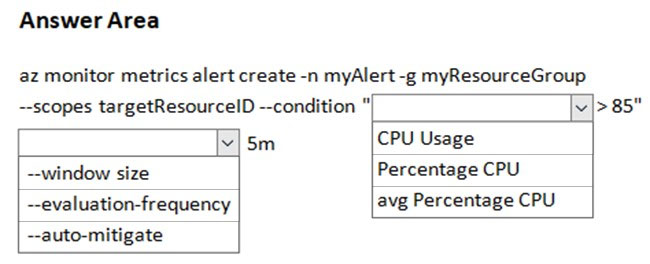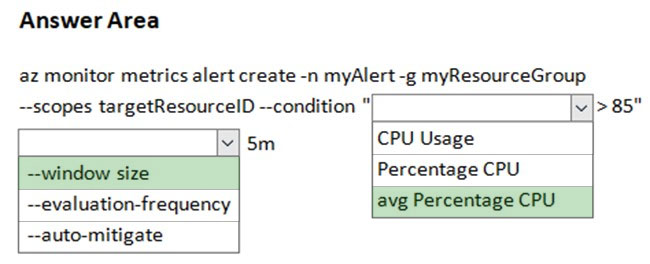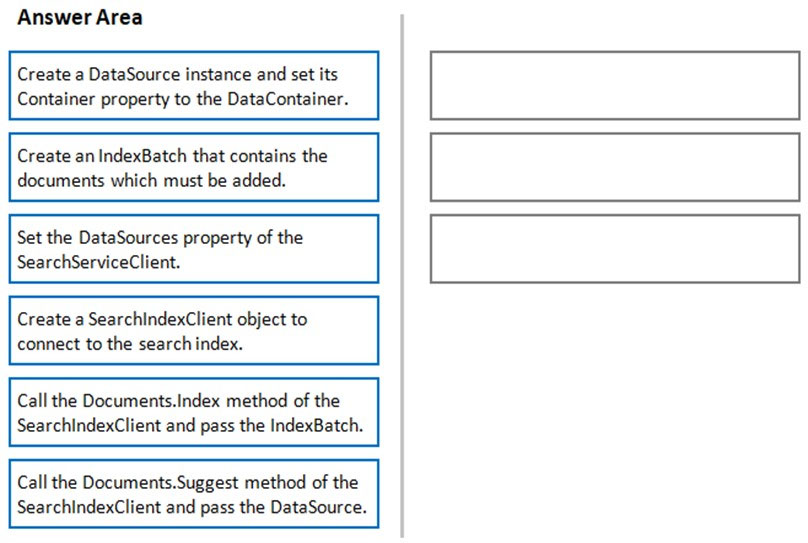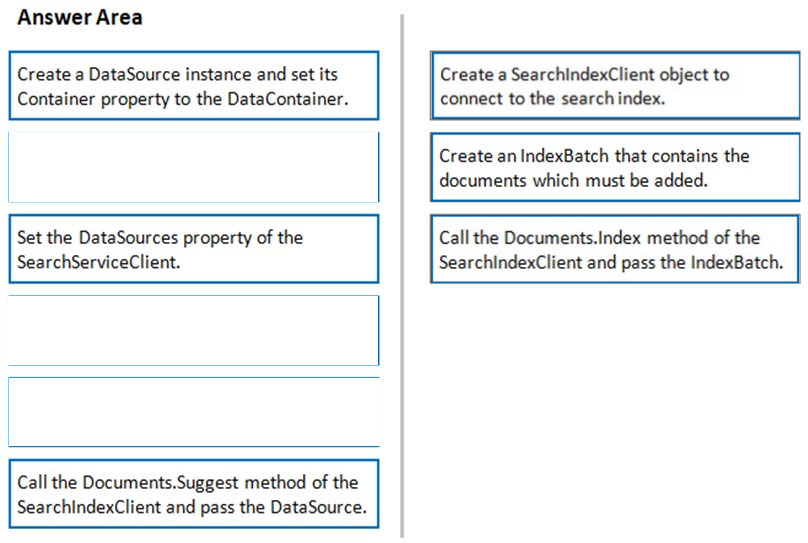Question:16
HOTSPOT -
You have developed a Web App for your company. The Web App provides services and must run in multiple regions.
You want to be notified whenever the Web App uses more than 85 percent of the available CPU cores over a 5 minute period. Your solution must minimize costs.
Which command should you use? To answer, select the appropriate settings in the answer area.
NOTE: Each correct selection is worth one point.
Hot Area:

Reference:
https://docs.microsoft.com/sv-se/cli/azure/monitor/metrics/alert
Question:17
Note: The question is included in a number of questions that depicts the identical set-up. However, every question has a distinctive result. Establish if the solution satisfies the requirements.
You are configuring a web app that delivers streaming video to users. The application makes use of continuous integration and deployment.
You need to ensure that the application is highly available and that the users' streaming experience is constant. You also want to configure the application to store data in a geographic location that is nearest to the user.
Solution: You include the use of Azure Redis Cache in your design.
Does the solution meet the goal?
- A. Yes
- B. No
Question:18
Note: The question is included in a number of questions that depicts the identical set-up. However, every question has a distinctive result. Establish if the solution satisfies the requirements.
You are configuring a web app that delivers streaming video to users. The application makes use of continuous integration and deployment.
You need to ensure that the application is highly available and that the users' streaming experience is constant. You also want to configure the application to store data in a geographic location that is nearest to the user.
Solution: You include the use of an Azure Content Delivery Network (CDN) in your design.
Does the solution meet the goal?
- A. Yes
- B. No
Question:19
Note: The question is included in a number of questions that depicts the identical set-up. However, every question has a distinctive result. Establish if the solution satisfies the requirements.
You are configuring a web app that delivers streaming video to users. The application makes use of continuous integration and deployment.
You need to ensure that the application is highly available and that the users' streaming experience is constant. You also want to configure the application to store data in a geographic location that is nearest to the user.
Solution: You include the use of a Storage Area Network (SAN) in your design.
Does the solution meet the goal?
- A. Yes
- B. No
Question:20
You develop a Web App on a tier D1 app service plan.
You notice that page load times increase during periods of peak traffic.
You want to implement automatic scaling when CPU load is above 80 percent. Your solution must minimize costs.
What should you do first?
- A. Enable autoscaling on the Web App.
- B. Switch to the Premium App Service tier plan.
- C. Switch to the Standard App Service tier plan.
- D. Switch to the Azure App Services consumption plan.
Reference:
https://docs.microsoft.com/en-us/azure/monitoring-and-diagnostics/monitoring-autoscale-get-started https://azure.microsoft.com/en-us/pricing/details/app-service/plans/
Question:21
Your company's Azure subscription includes an Azure Log Analytics workspace.
Your company has a hundred on-premises servers that run either Windows Server 2012 R2 or Windows Server 2016, and is linked to the Azure Log Analytics workspace. The Azure Log Analytics workspace is set up to gather performance counters associated with security from these linked servers.
You must configure alerts based on the information gathered by the Azure Log Analytics workspace.
You have to make sure that alert rules allow for dimensions, and that alert creation time should be kept to a minimum. Furthermore, a single alert notification must be created when the alert is created and when the alert is resolved.
You need to make use of the necessary signal type when creating the alert rules.
Which of the following is the option you should use?
- A. The Activity log signal type.
- B. The Application Log signal type.
- C. The Metric signal type.
- D. The Audit Log signal type.
Note: Signals are emitted by the target resource and can be of several types. Metric, Activity log, Application Insights, and Log.
Reference:
https://docs.microsoft.com/en-us/azure/azure-monitor/platform/alerts-metric
Question:22
You are developing a .NET Core MVC application that allows customers to research independent holiday accommodation providers.
You want to implement Azure Search to allow the application to search the index by using various criteria to locate documents related to accommodation.
You want the application to allow customers to search the index by using regular expressions.
What should you do?
- A. Configure the SearchMode property of the SearchParameters class.
- B. Configure the QueryType property of the SearchParameters class.
- C. Configure the Facets property of the SearchParameters class.
- D. Configure the Filter property of the SearchParameters class.
You can write queries against Azure Search based on the rich Lucene Query Parser syntax for specialized query forms: wildcard, fuzzy search, proximity search, regular expressions are a few examples.
Reference:
https://docs.microsoft.com/en-us/dotnet/api/microsoft.azure.search.models.searchparameters https://docs.microsoft.com/en-us/dotnet/api/microsoft.azure.search.models.searchparameters.querytype
Question:23
You are a developer at your company.
You need to update the definitions for an existing Logic App.
What should you use?
- A. the Enterprise Integration Pack (EIP)
- B. the Logic App Code View
- C. the API Connections
- D. the Logic Apps Designer
1. Sign in to the Azure portal.
2. From the left menu, choose All services. In the search box, find "logic apps", and then from the results, select your logic app.
3. On your logic app's menu, under Development Tools, select Logic App Code View.
4. The Code View editor opens and shows your logic app definition in JSON format.
Reference:
https://docs.microsoft.com/en-us/azure/logic-apps/logic-apps-enterprise-integration-overview https://docs.microsoft.com/en-us/azure/logic-apps/logic-apps-author-definitions
Question:24
Note: The question is included in a number of questions that depicts the identical set-up. However, every question has a distinctive result. Establish if the solution satisfies the requirements.
You are developing a solution for a public facing API.
The API back end is hosted in an Azure App Service instance. You have implemented a RESTful service for the API back end.
You must configure back-end authentication for the API Management service instance.
Solution: You configure Basic gateway credentials for the Azure resource.
Does the solution meet the goal?
- A. Yes
- B. No
Reference:
https://docs.microsoft.com/en-us/rest/api/apimanagement/apimanagementrest/azure-api-management-rest-api-backend-entity
Question:25
Note: The question is included in a number of questions that depicts the identical set-up. However, every question has a distinctive result. Establish if the solution satisfies the requirements.
You are developing a solution for a public facing API.
The API back end is hosted in an Azure App Service instance. You have implemented a RESTful service for the API back end.
You must configure back-end authentication for the API Management service instance.
Solution: You configure Client cert gateway credentials for the HTTP(s) endpoint.
Does the solution meet the goal?
- A. Yes
- B. No
Reference:
https://docs.microsoft.com/en-us/rest/api/apimanagement/apimanagementrest/azure-api-management-rest-api-backend-entity
Question:26
Note: The question is included in a number of questions that depicts the identical set-up. However, every question has a distinctive result. Establish if the solution satisfies the requirements.
You are developing a solution for a public facing API.
The API back end is hosted in an Azure App Service instance. You have implemented a RESTful service for the API back end.
You must configure back-end authentication for the API Management service instance.
Solution: You configure Basic gateway credentials for the HTTP(s) endpoint.
Does the solution meet the goal?
- A. Yes
- B. No
Service instance. It is an Azure resource and not an HTTP(s) endpoint.
Reference:
https://docs.microsoft.com/en-us/rest/api/apimanagement/apimanagementrest/azure-api-management-rest-api-backend-entity
Question:27
Note: The question is included in a number of questions that depicts the identical set-up. However, every question has a distinctive result. Establish if the solution satisfies the requirements.
You are developing a solution for a public facing API.
The API back end is hosted in an Azure App Service instance. You have implemented a RESTful service for the API back end.
You must configure back-end authentication for the API Management service instance.
Solution: You configure Client cert gateway credentials for the Azure resource.
Does the solution meet the goal?
- A. Yes
- B. No
Reference:
https://docs.microsoft.com/en-us/rest/api/apimanagement/apimanagementrest/azure-api-management-rest-api-backend-entity
Question:28
You are developing a .NET Core MVC application that allows customers to research independent holiday accommodation providers.
You want to implement Azure Search to allow the application to search the index by using various criteria to locate documents related to accommodation venues.
You want the application to list holiday accommodation venues that fall within a specific price range and are within a specified distance to an airport.
What should you do?
- A. Configure the SearchMode property of the SearchParameters class.
- B. Configure the QueryType property of the SearchParameters class.
- C. Configure the Facets property of the SearchParameters class.
- D. Configure the Filter property of the SearchParameters class.
Reference:
https://docs.microsoft.com/en-us/dotnet/api/microsoft.azure.search.models.searchparameters https://docs.microsoft.com/en-us/dotnet/api/microsoft.azure.search.models.searchparameters.querytype
Question:29
You are a developer at your company.
You need to edit the workflows for an existing Logic App.
What should you use?
- A. the Enterprise Integration Pack (EIP)
- B. the Logic App Code View
- C. the API Connections
- D. the Logic Apps Designer
Reference:
https://docs.microsoft.com/en-us/azure/logic-apps/logic-apps-enterprise-integration-overview https://docs.microsoft.com/en-us/azure/logic-apps/logic-apps-author-definitions
Question:30
You are a developer for a company that provides a bookings management service in the tourism industry. You are implementing Azure Search for the tour agencies listed in your company's solution.
You create the index in Azure Search. You now need to use the Azure Search .NET SDK to import the relevant data into the Azure Search service.
Which three actions should you perform in sequence? To answer, move the appropriate actions from the list of actions from left to right and arrange them in the correct order.
Select and Place:


Indexes.GetClient on the SearchServiceClient. Here we will use the first method.
2. Create the indexBatch with the documents
Something like:
var hotels = new Hotel[];
{
new Hotel()
{
HotelId = "3",
BaseRate = 129.99,
Description = "Close to town hall and the river"
}
};
ג€¦
var batch = IndexBatch.Upload(hotels);
3. The next step is to populate the newly-created index
Example:
var batch = IndexBatch.Upload(hotels);
try
{
indexClient.Documents.Index(batch);
}
Reference:
https://docs.microsoft.com/en-us/azure/search/search-howto-dotnet-sdk
No comments:
Post a Comment